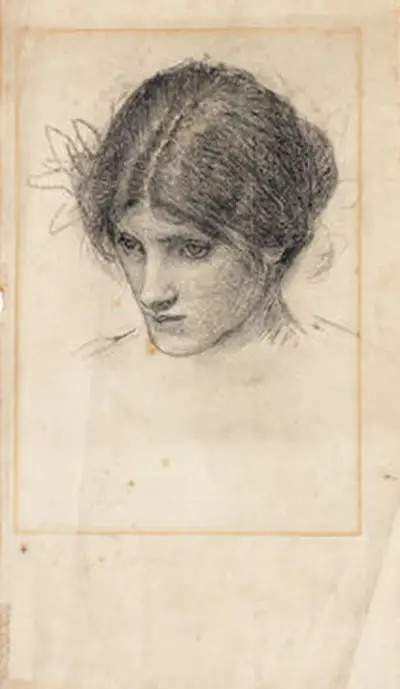This lesser known artwork from the career of John William Waterhouse was completed using a combination of pencil and charcoal, with the latter being used more aggressively over the top of the initial, subtle lines of pencil. The artist leaves a loose outline for the shoulders and focuses only on the features of this model's face. There appear to be some marks around her head which are not related to the composition, and perhaps are showing through from the other side of the paper, as many artists use both sides for their study drawings in order to save paper and space. Waterhouse also regularly used sketchbooks which would inevitably lead to sleeves of paper having several items on the same page, and then more work on the reverse. The majority of these books were separated into individual pages and sold off or gifted during and just after his lifetime. His widow placed large numbers of drawings in a particular London auction where lots included many sketches grouped together, such was the huge collection being sold off.
This particular drawing re-surfaced fairly recently and was auctioned in London, receiving a winning bid of £21,312, including the buyer's premium. It was presented at an event titled 19th Century and British Impressionist Art which was held on the 22nd of October, 2020. This period of British art brought about some of the nation's finest artists and so there is always plenty of domestic interest in such auctions. Bids from America are also fairly common as there continues to be a strong interest in British art within that nation too. Drawings such as these are much more accessible to the wider public, and so can attract new bidders who would otherwise have been put off by the huge prices which are normally received for John William Waterhouse paintings. This allows an auction house to then widen its scope of content and generally bolster its customer base. Information provided at the recent auction reveals that actually there was a drawing on the back of this artwork, which was specifically a study for Destiny, another of his best known works.
The facial expressions of the young women within this artist's paintings would play a crucial role in setting the tone and atmosphere within each one. This is why he would work so hard to improve his portraiture as best he could, although he was already highly accomplished in that regard by the late 1890s. He would also re-use many elements across different artworks, building up a signature style which was close to the Pre-Raphaelite movement, but unique enough that one could easily identify his paintings. His practice would therefore boost not only the work that he was preparing, but also future works because of this consistent approach, something which some critics rejected as unambitious, whilst the public today seem to adore many of these great works and are entirely unconcerned about the context of his career at that time.

